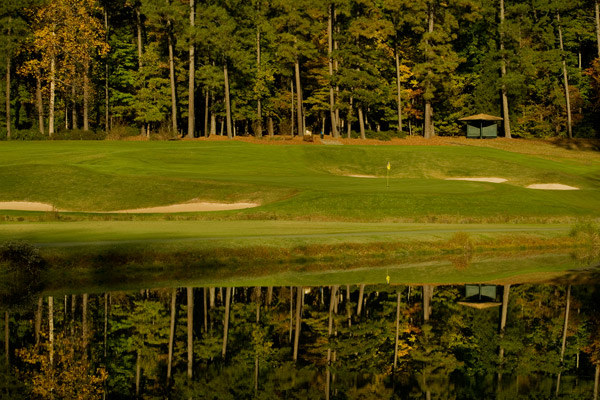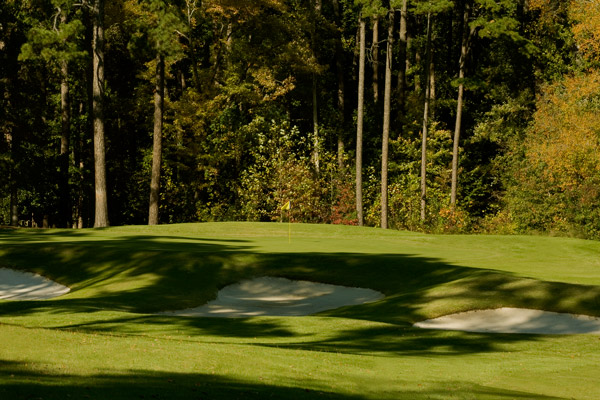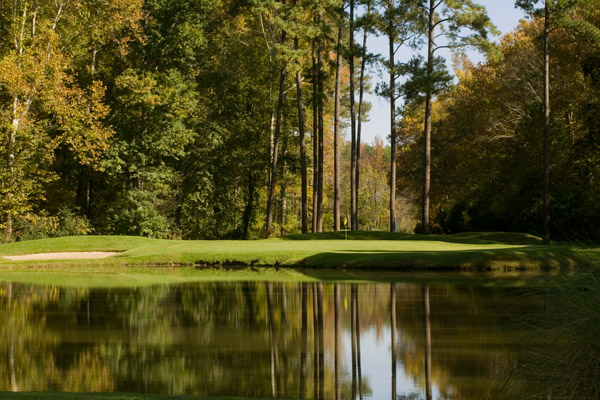
BY FRANK R. GIORDANO, JR.
DURHAM, North Carolina – There are many good reasons for going to Duke University, one of America’s top 10 major universities with its outstanding undergraduate, graduate, and professional schools, and its distinguished faculty and student body. However, getting accepted into this highly selective school and affording tuition and room and board make attendance there the privilege of only the brightest and most prosperous applicants. On the other hand, just about any golfer can get in a round on the Duke University golf course, without having SAT scores above 1500 and a trust fund in the hundreds of thousands. An investment of around $100 earns a golfing experience of a lifetime.
Duke’s ambition after the Second World War was to build a course that would stand alongside the nation’s finest university facilities. Its selection of Robert Trent Jones as course designer seemed particularly fitting, given his rising stature in an architectural field he was helping to define. Opened on the school’s West campus in 1957, the 7154 yard championship layout is one of the last of the “classic” era courses. Located on the same property as the Washington Duke Inn and Golf Club, the par 72 golf course is an open access resort course. Touring golfers who choose to stay at the elegant 279 room hotel, with its fine dining and full range of amenities, get a discounted rate for their rounds of golf. A good neighbor to the city of Durham and the state of North Carolina, Duke offers a superb, challenging, and enjoyable experience for everyone who visits, resort guests and local golfers as well as members of the Duke University faculty, student body, and staff.

An eminent university engages a distinguished faculty, and it’s not surprising that the golf course at Duke is managed by professionals of very high standing as well. Ed Ibarguen, known locally as “The Legend,” has been a fixture at Duke since 1988. Ed was inducted into the national PGA Hall of Fame for a lifetime’s career of excellence as a teacher, leader, and mentor to generations of golf professionals. After stints at the Pine Needles resort and as the head professional at Pinehurst’s #6 course, Rob Pilewski joined Duke in 2019 as the PGA Head Golf Professional. Rob has a robust instructional team of nine teachers on staff, who offer lessons and clinics to players of all ability levels.
Since its beginning the Duke course has hosted US Open qualifiers, two NCAA Championships for men (in 1962 and 1991), and intercollegiate tournaments such as the Meyer Invitational for about 15 universities in the Mid-Atlantic region, conducted the week after my visit. For their local community and charity organizations, the university has opened the facility. Significantly, the course has been the proving ground for Duke’s female golfers; perennial championship contenders since the late 1990’s, Duke’s women have won seven Division 1 titles under coach Dan Brooks. Recruiting talent from all over the globe has had much to do with Dan’s success, but the challenging course itself has helped fashion his top players into national standouts. The precocious Beth Bauer may be the best known of the Duke women champions. Traditionally one of the very finest college golf courses in America, Duke has been ranked as high as #5 by a prestigious golf publication. In the state of North Carolina, a golfing landscape featuring numerous exceptional courses by Donald Ross and Tom Fazio, Duke’s Jones course currently ranks No. 40.

At Duke, the senior Trent Jones expressed his design philosophy that each hole should be a “hard par, but an easy bogey.” The land available to him in the Duke Forest provided a wide selection of natural features to get a course architect’s creative juices flowing: rolling, sloping land offering elevation changes throughout, broad open areas permitting the shaping of doglegs left and right, numerous interesting sites for tees and greens, and meandering creeks that challenge the player’s mental judgment in club selection, as well as physical, ball-striking talent. The flowing land enabled Jones ample opportunities for creating water hazards on several holes. Best of all, the course’s design features are all visible from the tees. Directional signals are continuously letting players know where — and where not — to place shots, where to avoid the large fairway hazards, where to place layups on par 5s. Fair and inviting, the course welcomes every player to focus and give it their best shot. According to Rob Pilewski, Duke is a walker-friendly course. For the benefit of the health-conscious golfer, for whom golf is essentially a walking game, Jones located tee boxes close to the courses’s putting surfaces. A round at Duke is never “a good walk spoiled,” as the famous humorist Mark Twain once opined … in one of his most infamous, least humorous pronouncements.
Since opening, Duke has maintained its relationship with the family of Robert Trent Jones over the decades. Any refurbishment or modernizing of playing surfaces has been done by the Jones family design organizations, with Rees Jones carrying forward his dad’s work initially. Long known as the US Open “course doctor” for his work in enhancing the tactical challenges and the beauty of the Open venues, Rees played for Yale University in the 1962 NCAA event at Duke. Rees oversaw the transition of the course’s new Bermuda miniverde greens, the go-to choice for putting surfaces in the southern US. This past summer, he supervised the refurbishment and expansion of the course’s fairway bunkers. In order to make the course more friendly for seniors, Duke plans in the near future to add another set of “Forward” tees. A most welcome development indeed! There’s a fine set of par 3s at Duke, both visually attractive and demanding of precise iron play. Don’t miss the greens, though, as graveyard conditions and aquatic death loom just beyond the frog’s hair.

For this is a very big golf course, a most engaging tourist golf course, whose wide fairways invite the player to tee it up, let it fly, and enjoy a day in an urban forest. It takes a real poor tee shot to find trouble on most holes, although the course’s rough areas are pretty daunting and require the top notch collegians who train here to use caution when selecting a driving club. Most greens are protected by numerous sand bunkers, often clustered together, often quite deep and sometimes tucked close to the putting surfaces. The large undulant greens are in excellent condition, most often sloping from back to front; each offers several interesting pin positions and requires sound management of distance control. For those unfamiliar with mini-verde greens, pitching and chipping will seem unusually challenging, as longer shots tend to bounce and run, while shorter ones resist spinning and holding.
There’s no secret to scoring well at Duke , Pilewski says. Players must be very good at making decisions from about 100 yards in and around the large sloping greens and tight runoff areas. Fortunately, Duke’s golf complex includes a splendid 20+ acre practice facility. In addition to the obligatory driving range and putting green, there’s a versatile short-game area and practice bunker, both of which offer invaluable prep before teeing off.

Of particular interest to golfers in the Northeast, Connecticut resident and Duke alum Dick Siderowf honed his remarkable skills while competing for Duke in the mid 1950s. This writer, at age 13, carried the elegantly dressed high school senior’s bag in the Connecticut Amateur championship at the Brooklawn Country Club outside Bridgeport. The following year, after his freshman season at Duke, Siderowf began his long reign over New England’s amateur golfers with a victory in this event and subsequent triumphs in both amateur and open championships in the region. He capped his brilliant career with two British Amateur trophies, the second of which he won at St. Andrews.
(Frank Giordano Jr. Ph.D., has been living the dream playing golf, writing about it and for the past 23 years painting golf landscapes and murals from his home in the Pinehurst, North Carolina area. His work can be found at https://www.etsy.com/shop/giordanofrank )











Leave a Reply